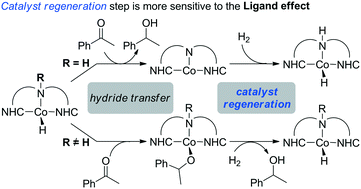Theoretical study of the ligand effect on NHC–cobalt-catalyzed hydrogenation of ketones†
Abstract
The ligand effect on cobalt-catalyzed hydrogenation of ketones is systematically studied using DFT calculations. Computational results revealed that the outer-sphere hydride transfer step is not overly dependent on the N–H substructure of the ligand because in addition to hydrogen bonding interaction, other non-covalent interactions between pincer ligands and ketones also contribute to the stabilization of the hydride transfer transition state. Instead, the rate-determining catalyst regeneration step, which occurs after hydride transfer, is determined to be more sensitive to the N–H group. Besides, the origin of the reactivity difference of various ligands is also investigated. The low reactivity of NHC ligands not containing an N–H substructure is attributed to the increased distortion in the catalyst regeneration step. Phosphine ligands also have a similar defect in terms of catalyst regeneration. In this case, the relatively weak coordination ability of phosphine ligands compared with that of NHC ligands results in the higher energy barrier in the catalyst regeneration step. The strong coordination ability of NHC ligands originates from the additional d → p back-donation in NHC–Co interaction. According to this study, the impact of the ligand effect on ketone hydrogenation reactions mainly concentrates in the catalyst regeneration step.

- This article is part of the themed collection: 2019 Catalysis Science & Technology HOT Articles


 Please wait while we load your content...
Please wait while we load your content...